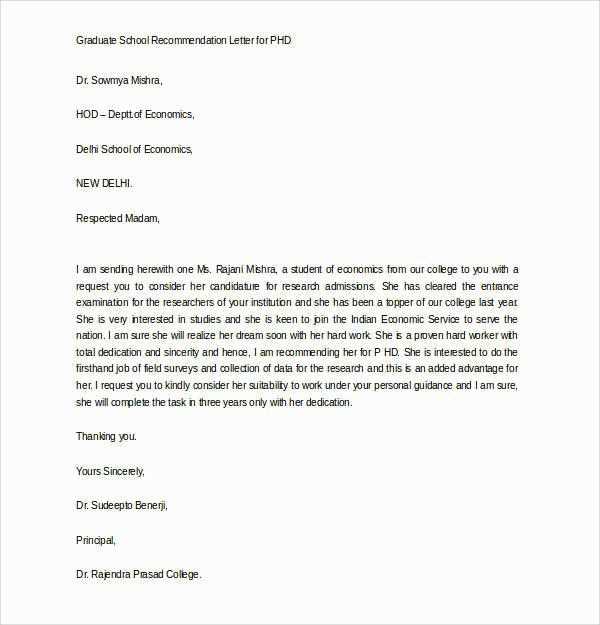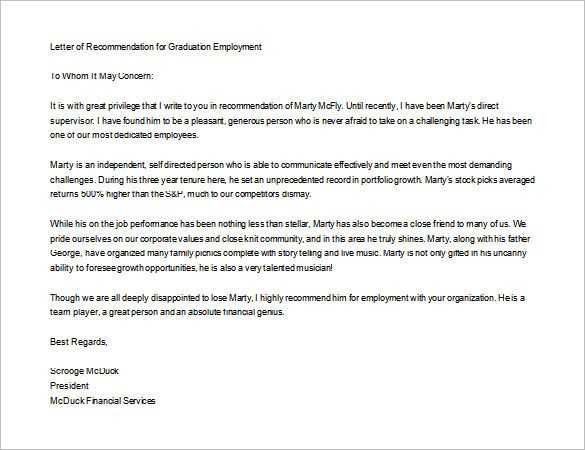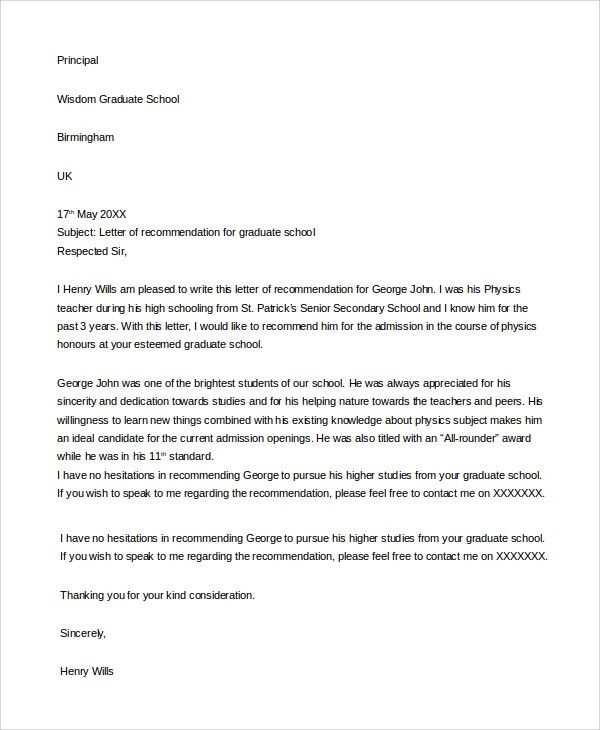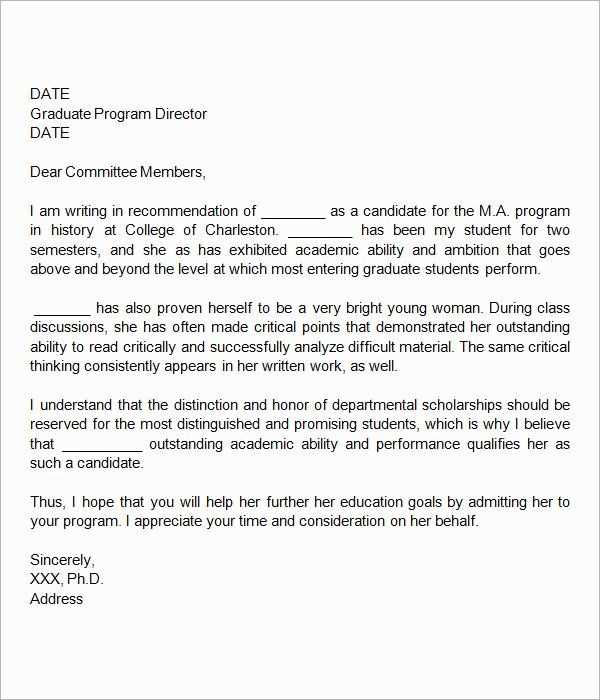Graduate School Recommendation Letter Template Guide

Creating a compelling endorsement for a candidate applying to higher academic programs can make a significant difference in their acceptance. Such letters serve as a powerful tool in showcasing an applicant’s strengths, character, and potential for success in advanced studies.
Crafting a persuasive endorsement requires careful consideration of both the content and structure. The goal is to present a well-rounded view of the applicant’s abilities, achievements, and personal qualities that align with the requirements of the program they are seeking. Each element in the letter should be tailored to highlight the most relevant and impactful traits.
Whether you are writing on behalf of a student, a colleague, or a mentee, providing a clear, honest, and thoughtful perspective will help admissions committees make informed decisions. The right approach can significantly enhance the chances of an applicant standing out among others in a competitive process.
What to Include in a Recommendation Letter
When writing an endorsement for a candidate applying to a higher academic program, it is important to highlight key aspects of their qualifications and character. A well-structured endorsement should not only emphasize the applicant’s strengths but also provide concrete examples of their abilities and achievements. This serves to create a compelling case for their suitability for the program.
Start by introducing your relationship with the applicant, specifying how long and in what capacity you have known them. This context helps the reader understand your perspective. Next, focus on the individual’s skills, work ethic, and achievements that directly relate to their potential success in advanced studies. Providing specific instances of their accomplishments or positive traits adds credibility to your statements.
It’s essential to express confidence in the candidate’s ability to thrive in the rigorous academic environment they are applying to. Conclude with a strong endorsement that reassures the admissions committee of the applicant’s readiness and fit for the program. A well-rounded and honest evaluation will significantly enhance the applicant’s chances of standing out among others.
Understanding the Purpose of a Recommendation
An endorsement written for an applicant plays a vital role in the selection process for advanced educational programs. Its primary purpose is to provide a third-party perspective on the candidate’s qualifications, skills, and character, offering insight that may not be fully captured in their application materials. Through a well-crafted endorsement, the applicant’s strengths and potential for success can be clearly articulated, helping admissions committees make more informed decisions.
Unlike other application documents, an endorsement presents an opportunity to describe the applicant beyond their academic achievements. It provides a chance to highlight their personal qualities, work ethic, and the ways in which they’ve demonstrated leadership, resilience, or collaboration. These qualities can make a significant difference in how the candidate is perceived by those reviewing their application.
| Purpose of Endorsement | Impact on Applicant’s Chances |
|---|---|
| Highlights skills and abilities not visible on paper | Can showcase strengths in areas like leadership, teamwork, and communication |
| Offers insight into the candidate’s personal qualities | Gives the admissions committee a deeper understanding of the applicant’s character |
| Reinforces qualifications with real-world examples | Helps solidify the applicant’s readiness for a challenging academic environment |
Ultimately, a strong endorsement strengthens the candidate’s overall application, providing additional evidence that they are well-suited for the program they are applying to.
How to Format a Graduate Letter Properly

Proper formatting is crucial when creating a formal endorsement for an applicant. It ensures that the content is presented in a professional and easy-to-read manner, making it more likely to be taken seriously by the recipient. A well-organized document helps emphasize key points and allows the reader to quickly grasp the most important information about the candidate.
Structure and Organization
The document should begin with a formal salutation, typically addressed to the admissions committee or specific program director. Follow this with a brief introduction that establishes your relationship with the applicant and provides context for your endorsement. The body of the document should focus on the candidate’s qualifications, using clear paragraphs to discuss their skills, achievements, and character. Conclude with a strong closing statement that reaffirms your support and confidence in the applicant.
Formatting Tips

Ensure that the document is neatly aligned and spaced, with each paragraph clearly separated. Use a professional font like Times New Roman or Arial in a readable size, typically 12-point. Keep the length of the document concise, ideally no longer than one page, to maintain the reader’s attention. If you’re submitting electronically, save the file as a PDF to preserve formatting and ensure compatibility across different devices.
Common Mistakes to Avoid in Letters
When composing an endorsement for an applicant, it’s essential to avoid common pitfalls that can undermine the impact of your support. Mistakes in tone, content, or structure can weaken the message and detract from the applicant’s strengths. Recognizing and steering clear of these errors will help you create a more compelling and effective document.
One of the most common mistakes is being too vague or general in your praise. Avoid using clichés or overused phrases that don’t provide concrete examples of the applicant’s abilities. Instead, focus on specific instances where the candidate has demonstrated exceptional skills or qualities that align with the demands of the program.
Another issue to watch out for is failing to tailor the endorsement to the specific program or field. Generic statements that do not directly address the applicant’s potential within the academic context they are applying for can make the document feel impersonal. Customizing your endorsement to reflect the unique requirements and challenges of the program shows that you understand both the applicant’s potential and the demands they will face.
Finally, avoid using a dismissive or overly casual tone. While you want to convey genuine support, your language should remain formal and professional throughout. Ensure that your endorsement is both respectful and confident in its assessment of the applicant’s qualifications.
Tips for Writing a Strong Recommendation

Writing a powerful endorsement can significantly impact an applicant’s chances of being accepted into a competitive program. To create a convincing and persuasive document, it’s important to focus on clarity, specificity, and a balanced presentation of the candidate’s strengths. A well-crafted endorsement can make a lasting impression on the admissions committee.
Provide Concrete Examples
Instead of simply stating that the applicant is “hardworking” or “intelligent,” provide specific examples that showcase these traits in action. Describe instances where the candidate demonstrated exceptional skills or overcame challenges. This adds credibility to your evaluation and helps paint a more vivid picture of the applicant’s potential.
Be Honest and Balanced
While it’s important to highlight the applicant’s strengths, don’t shy away from offering a balanced view. If there are areas for growth, mention them thoughtfully and frame them as opportunities for development. A candid and thoughtful assessment will convey sincerity and build trust with the reader.
Essential Elements of a Convincing Letter
A strong endorsement requires a careful balance of essential components to make it both credible and compelling. By focusing on specific details, clear structure, and a confident tone, you can ensure that the applicant stands out in the admissions process. Each element plays a key role in crafting an effective document that supports the applicant’s qualifications and potential.
Key Components
- Introduction: Briefly introduce yourself and explain your relationship to the candidate, giving context to your perspective.
- Specific Examples: Provide concrete instances where the candidate demonstrated important skills or qualities, such as leadership, problem-solving, or collaboration.
- Strengths and Achievements: Highlight the applicant’s most relevant accomplishments, emphasizing their impact and significance in the context of the program they are applying to.
- Personal Qualities: Showcase the applicant’s character, work ethic, and other intangible qualities that make them a great fit for the program.
- Conclusion: Summarize your support and express confidence in the applicant’s potential, reaffirming why they would excel in the academic environment they are applying to.
Organizing the Content
Ensure the content is well-organized with clear paragraphs and logical flow. Begin with an engaging opening, followed by detailed support, and end with a strong, positive conclusion. Avoid redundancy by making each section unique and relevant to the applicant’s qualifications and potential.